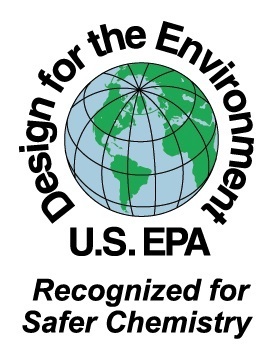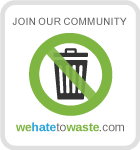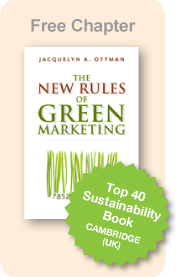Jacquie Ottman's
Green Marketing Blog
EPA’s Design for the Environment Label — A Route to Safer Chemicals
November 21, 2011 by Jacquelyn Ottman
Some chemicals are safer than others, and the U.S. EPA’s Office of Pollution Prevention and Toxics’s voluntary Design for the Environment label can help consumers identify all purpose cleaners, laundry detergents and oth er products that have met performance measures and are known to contain the safest possible ingredients. Since its inception in 1997, the label has been earned by over 2700 products. (Full disclosure: DfE is a former client of mine.)
er products that have met performance measures and are known to contain the safest possible ingredients. Since its inception in 1997, the label has been earned by over 2700 products. (Full disclosure: DfE is a former client of mine.)
A product of EPA’s now twenty-year-old Design for the Environment (DfE) Program, the DfE label is based upon product review criteria developed with stakeholders and published in the form of a standard — the DfE Standard for Safer Products. It defines what constitutes a safer chemical and ensures that each product that has earned the DfE label has passed the strict ingredient criteria and pass/fail thresholds, which give light to which chemicals are safe for use.
The product review also considers life cycle aspects including chemical exposures during use and end-of-life, the “hot spots” in the life cycle of chemical-based products, as well as other important areas like VOCs, packaging, and audits.
With transparency now a big green consumer watchword, the program includes a first-of-its-kind ingredient disclosure provision that will make the safer chemistry aspects of labeled products more visible and valued.
Business Benefits
Like all ecolabels with the exceptions of Recycled and Energy Star, the DfE label is not yet well known among consumers (underscoring the need for labelers to do their own promotion). However, various marketing opportunities suggest labeling one’s product is still good for business.
For starters, DfE-labeled products are likely to get preferential purchasing treatment in the 22 U.S. states that adhere to the EPA’s the Environmentally Preferable Purchasing guidelines; and 8 states require the label outright on all the cleaning products that they buy under their green procurement programs.
As I write, the DfE standard is being proposed as a likely part of the GSA’s advantage purchasing program, set to take effect in 2012. The US Green Building Council is considering DfE for their new existing buildings operations and maintenance LEED standard, and greener and safer cleaning products will likely benefit as more and more businesses become dedicated to becoming green and promoting a healthy workplace.
Retailers are getting behind the program, too. Wal-Mart is encouraging their suppliers to get the DfE label, and Safeway has promoted DfE at the shelf. And unions gladly work with the DfE program on what is known as “Alternative Assessments” of various products in order to choose ones that help to ensure worker safety.
Looking toward the future, meeting the requirements of the DfE label today could help smooth the way toward compliance of pending and expected regulations -— such as the Safer Consumer Products regulations recently proposed by the State of California’s Department of Toxic Substance Control.
Free Advice
There’s more to the Design for the Environment label than simple marketability. The chemistry-oriented resources of the EPA are offered to businesses in the hope that they will incorporate cleaner alternatives into their products. Companies that have already taken advantage of the DfE program’s Safer Formulator Program include SC Johnson, Method and many others — large and small; the free technical advice they received to help guide their products to compliance with DfE’s standards might otherwise have cost thousands of dollars.
Jacquelyn Ottman is an expert adviser on green marketing to Fortune 500 firms, entreprenuerial companies, and the U.S. government. She is the author ofThe New Rules of Green Marketing: Strategies, Tools and Inspiration for Sustainable Branding (Berrett-Koehler, 2011)
Mera McGrew contributed to this post. Mera is an associate at J. Ottman Consulting, Inc. and a recent graduate of Vassar College.
This blog post was previously published on SustainableLifeMedia.com.
Recent blog posts:
• Why Education is Key to Green Marketing Success
• How to Choose the Right Eco-Label
• Toyota’s Prius: Different Strokes for Different Folks
Subscribe to Jacquie Ottman’s Green Marketing Blog. Link here.



 ShareThis
ShareThis

